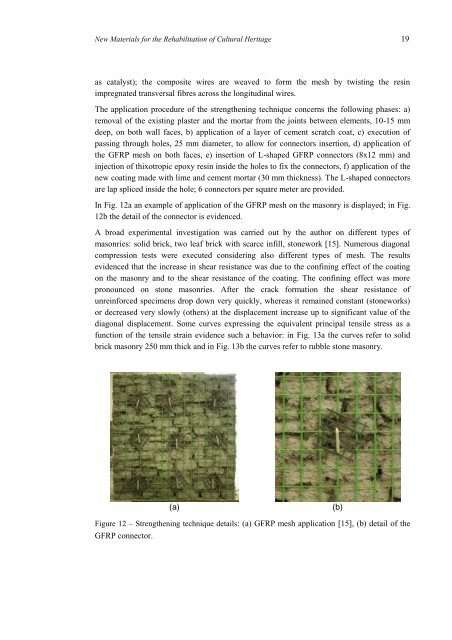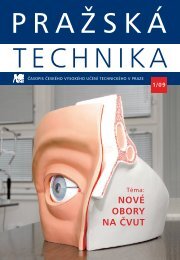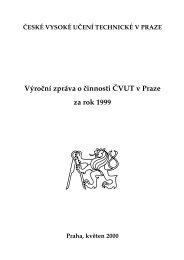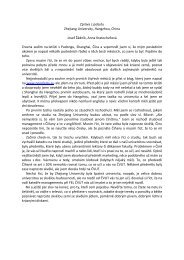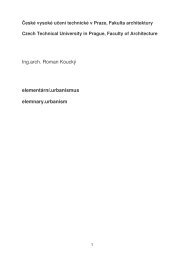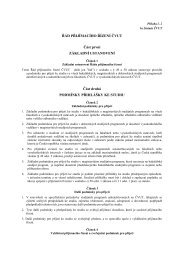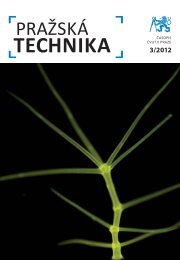New Materials for the Rehabilitation of Cultural Heritage - Czech ...
New Materials for the Rehabilitation of Cultural Heritage - Czech ...
New Materials for the Rehabilitation of Cultural Heritage - Czech ...
You also want an ePaper? Increase the reach of your titles
YUMPU automatically turns print PDFs into web optimized ePapers that Google loves.
<strong>New</strong> <strong>Materials</strong> <strong>for</strong> <strong>the</strong> <strong>Rehabilitation</strong> <strong>of</strong> <strong>Cultural</strong> <strong>Heritage</strong> 19<br />
as catalyst); <strong>the</strong> composite wires are weaved to <strong>for</strong>m <strong>the</strong> mesh by twisting <strong>the</strong> resin<br />
impregnated transversal fibres across <strong>the</strong> longitudinal wires.<br />
The application procedure <strong>of</strong> <strong>the</strong> streng<strong>the</strong>ning technique concerns <strong>the</strong> following phases: a)<br />
removal <strong>of</strong> <strong>the</strong> existing plaster and <strong>the</strong> mortar from <strong>the</strong> joints between elements, 10-15 mm<br />
deep, on both wall faces, b) application <strong>of</strong> a layer <strong>of</strong> cement scratch coat, c) execution <strong>of</strong><br />
passing through holes, 25 mm diameter, to allow <strong>for</strong> connectors insertion, d) application <strong>of</strong><br />
<strong>the</strong> GFRP mesh on both faces, e) insertion <strong>of</strong> L-shaped GFRP connectors (8x12 mm) and<br />
injection <strong>of</strong> thixotropic epoxy resin inside <strong>the</strong> holes to fix <strong>the</strong> connectors, f) application <strong>of</strong> <strong>the</strong><br />
new coating made with lime and cement mortar (30 mm thickness). The L-shaped connectors<br />
are lap spliced inside <strong>the</strong> hole; 6 connectors per square meter are provided.<br />
In Fig. 12a an example <strong>of</strong> application <strong>of</strong> <strong>the</strong> GFRP mesh on <strong>the</strong> masonry is displayed; in Fig.<br />
12b <strong>the</strong> detail <strong>of</strong> <strong>the</strong> connector is evidenced.<br />
A broad experimental investigation was carried out by <strong>the</strong> author on different types <strong>of</strong><br />
masonries: solid brick, two leaf brick with scarce infill, stonework [15]. Numerous diagonal<br />
compression tests were executed considering also different types <strong>of</strong> mesh. The results<br />
evidenced that <strong>the</strong> increase in shear resistance was due to <strong>the</strong> confining effect <strong>of</strong> <strong>the</strong> coating<br />
on <strong>the</strong> masonry and to <strong>the</strong> shear resistance <strong>of</strong> <strong>the</strong> coating. The confining effect was more<br />
pronounced on stone masonries. After <strong>the</strong> crack <strong>for</strong>mation <strong>the</strong> shear resistance <strong>of</strong><br />
unrein<strong>for</strong>ced specimens drop down very quickly, whereas it remained constant (stoneworks)<br />
or decreased very slowly (o<strong>the</strong>rs) at <strong>the</strong> displacement increase up to significant value <strong>of</strong> <strong>the</strong><br />
diagonal displacement. Some curves expressing <strong>the</strong> equivalent principal tensile stress as a<br />
function <strong>of</strong> <strong>the</strong> tensile strain evidence such a behavior: in Fig. 13a <strong>the</strong> curves refer to solid<br />
brick masonry 250 mm thick and in Fig. 13b <strong>the</strong> curves refer to rubble stone masonry.<br />
Figure 12 –Streng<strong>the</strong>ning technique details: (a) GFRP mesh application [15], (b) detail <strong>of</strong> <strong>the</strong><br />
GFRP connector.<br />
(a) (b)


